Here is a timeline of the Dutch coronavirus strategy. It aims to be a neutral knowledge resource for anyone interested in the way the coronavirus spread through the Netherlands, and particularly how the Dutch government responded to it.
January
January was the month in which preliminary plans were made to deal with the coronavirus in the Netherlands.
- January 18th: RIVM is the National Institute for Public Health and the Environment. On the 18th RIVM tells a newspaper there is only a 'small chance' that the coronavirus will show up in Europe. 'There are no direct flights from Wuhan to The Netherlands', a spokesperson added.
- January 22nd: RIVM says they are preparing for a potential outbreak, even though they think the chance of the virus entering the Netherlands is small.
- January 24th: Minister for medical care and sports Bruno Bruins informs the Dutch parliament that the risk of the coronavirus spreading to Europe is still considered 'small'.
- January 27th: OMT stands for Outbreak Management Team. It is part of the Center for Infectious Disease Control which is part of the RIVM. The OMT is the main advisory council to the Dutch government during the corona crisis. On January 27th Bruno Bruins informs parliament in a letter about COVID-19, after having been advised by the OMT on January 24th. The OMT advises to classify the new coronavirus as a category A disease, which means any patient suspected of having been infected, has to be reported to a regional GGD by the main practitioner and laboratory manager. This is a practical necessity for isolation of patients and for contact tracing (+quarantaine). GGD's are municipal health services, they are responsible for doing (a part of the) testing and all contact tracing. According to the OMT, entry screening at airports is not useful, due to not finding any SARS infected person this way in 2002-2003.
- January 27th: Although there is a chance the virus may spread to The Netherlands, head of the OMT and director of the center for infectious disease control at RIVM Jaap van Dissel says it will probably be limited to just a handful of cases, because we know which protocols to follow and which measures to take.
- January 28th: RIVM thinks the virus is not very contagious and not easily transmitted between people.
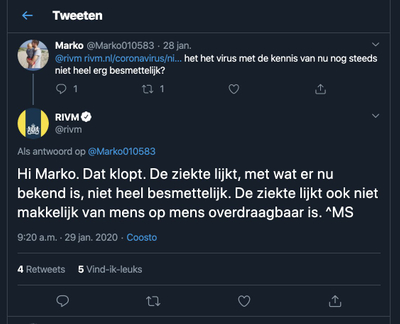
- January 28th: Thierry Baudet from far-right party FvD requests an emergency debate, because of the lack of border control. Request is denied, February 6th there will be a debate.
- January 29th: From now on there is an obligation to report suspected infected cases (disease category A).
February
February was later considered the 'lost month'.The virus was being underestimated, while it was already spreading undetected. Allowing carnival to continue and vacationers to visit northern Italy were important factors in increasing the first wave.
- February 3rd: GGD Hart voor Brabant and Brabant Zuid-Oost put out a warning that they have serious capacity problems. "We won't be able to keep this up for a long time", they warn.
- February 3rd: RIVM says we are prepared in case the virus pops up in The Netherlands.
- February 4th: In the technical briefing to parliament, Jaap van Dissel states that containment can be successful and that right now it's the aim for The Netherlands. But he also mentions the possibility of allowing the virus to spread while protecting vulnerable groups of people if the virus turns out to be similar to the flu. But emphasizes that this is unknown and that it is necessary to prepare for the worst.
The question is, of course, when you will reach the tipping point, when you will say: the amount of people becoming only mildly ill is so large, and the percentage that eventually dies is so small, that it actually reminds us of diseases that we have known for a long time, such as the flu. [...] At some point you may arrive at a tipping point where you might say: maybe we should start fighting this differently, or just focus on vulnerable groups and other than that, allow it to spread.
- February 4th: Jaap van Dissel advises against face masks, stating: 'not a realistic way to slow the spread of the coronavirus'.
- February 7th: In a TV show, OMT member and virologist Marion Koopmans wonders how long China can keep containing the virus, because the effects are enormous.
- February 10th: Enormous amounts of PPE (face masks etc.) flown to China.
- February 11th: GGD West Brabant and GGD Hart van Brabant are asked via email by another GGD why they are trying to increase capacity to do testing & contact tracing for expected coronavirus patients, as they have received instructions to refrain from doing so, reports Omroep Brabant. They are even visiting consumer stores in efforts to purchase protective face masks.
- February 18th-19th: In an international meeting, Jaap van Dissel seems to already be considering mitigation as a strategy.

- February 20th: Jaap van Dissel states in the technical briefing, that with the current knowledge he finds testing useless for people without symptoms. He also states that the severity of the COVID-19 outbreak in China is comparable to the current flu season in The Netherlands.
- February 21st: Woman ends up on the ICU of Beatrix hospital Gorinchem. Had symptoms for weeks before this.Only later it is found out that she is COVID-19 positive, in retrospect she is the first patient with COVID-19 confirmed.
- February 21st: Aura Timen is a prominent member of the OMT. She is head of the national coördination of control of infectious disease at the RIVM. On this date she holds a lecture at a symposium where she states that if The Netherlands will not be able to contain the virus, a switch to a mitigation strategy will need to be made, because as she says 'At some point, a country's containment capacity comes to an end of course'. She also says that it's unthinkable that cities will be locked down in The Netherlands, because there would be too little support for that from the population.
- February 23-25: Carnaval is celebrated (main festivities).
- February 24th: RIVM says corona is similar to the flu.
- February 24th: Aura Timen says on the radio that we are nearing a tipping point, where the WHO will have to decide if the virus can be contained, or needs to be mitigated.
- February 26th: OMT meeting.
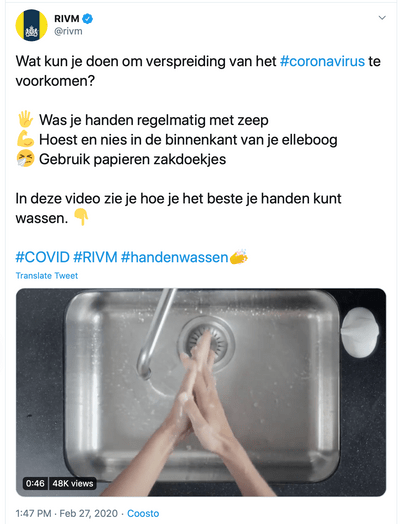
- February 26th: GGD Hart voor Brabant & GGD West-Brabant draw the conclusion that they will have insuffient capacity to do basic contact tracing for even just one case, as reported by Omroep Brabant. The regional public broadcasting organization also reported in the same article that these two regional health centers had tried to scale up their testing & tracing capacity, but found it challenging due to previous budget cuts and paternity leave of several employees.
- February 27th: The first Dutch patient is tested positive for coronavirus in Tilburg, The Netherlands. Because of this, people are instructed to wash hands more often, sneeze/cough in one's elbow and use paper handkerchiefs.
- February 27th: GGD-GHOR director Sjaak de Gouw states the regional health centers are "ready for the first 1.000 cases."
- February 27th: On the day the first coronavirus patient is confirmed in the city of Tilburg, its mayor (Theo Weterings) greenlights a soccer match to be held on the following day.
- February 28th: Omroep Brabant reports in August 2020 that on this day, GGD Hart voor Brabant has insufficient capacity
- February 28th: Van Dissel says Carnaval is not a big issue, since according to him it’s celebrated in small groups of people familiar with each other. The corona outbreak will turn out to be particularly intense in the area's where Carnaval was celebrated. (TV interview with quote + released interview with part of the quote cut out)
- February 28th: Aura Timen compares corona to the flu, even though she portrays it as having a 2% mortality rate (flu: 0,1%).
- February 28th: Second OMT report, which has a change of tune. It hints at necessary preparations for the fact that it may be too late for containment. It also hints at test material shortages and the possible need for triage.
March
March is the month wherein the shift is made from an apparent attempt at containment to a mitigation strategy ('maximum control'). First in the province North Brabant, then in The Netherlands as a whole. The 'intelligent lockdown' is introduced. ICU capacity is being increased. There are worries about ICU capacity, fearing an 'Italian situation' even and having to triage patients.
- March 1st: OMT member Marc Bonten says in a TV interview: 'Slowly, but surely we are going towards the point that we say: containment as it is called -the eradication of the virus in the human population- is probably not going to succeed, this means that we have to switch to mitigation.' He also talks about some relaxing of measures in China that is supposedly causing a resurgence. According to our research, there has been no relaxing of measures in China at this point in time and also no resurgence, but instead an ongoing decline in the number of cases. Tweet about the video here.
- March 3rd: First meeting MCCb (ministerial crisis management committee). 23 known cases of coronavirus infection in The Netherlands.
- March 3rd: RIVM requests that the government changes the travel guidance for northern Italy. (Article) There is still talk of attempts to 'contain' the virus, but prime minister Mark Rutte indicates that a next phase may be coming where mitigation is necessary: "I can't say anything about that now, but if the numbers are so great that we have to move to another phase, we have to be ready."
- March 6th: Third OMT meeting. Advisory report not to become public until March 11th.
- March 6th: RIVM advises people in North Brabant to limit contacts if they have cold symptoms. (Article)
- March 6th: First official COVID-19 death. (Article)
- March 9th: The Dutch government announces extra measures: Dutch citizens should refrain from shaking hands. Regrettably, prime minister Mark Rutte goes on to shake Jaap van Dissel's hand at the end of the press conference.
- March 11th: the WHO declares the COVID-19 outbreak a 'pandemic'. However, the WHO Director-General goes on to say:
Let me be clear: describing this as a pandemic does not mean that countries should give up. The idea that countries should shift from containment to mitigation is wrong and dangerous.
This is a crucial step, the Dutch government seems to do just that. With the removal of the obligation to report new infections, contact tracing is essentially halted.
- March 12th: According to RIVM's protocol it is no longer obligatory to report suspected corona cases, only confirmed cases. Later, someone finds out that there's no legal basis for this. According to the law COVID-19 remains an A disease with obligation to report suspected cases.
- March 12th: Press conference: From now on, meetings with 100+ people are forbidden, people are advised to work from home if possible and to stay home when they have symptoms. Because of this, people with mild symptoms will no longer be tested (not mentioned in the conference or official update). It is said that North Brabant has entered the mitigation phase, while containment is still attempted in the rest of the country. In North Brabant, they couldn't find the source for some of the infections and didn't have enough time for contact tracing.
- March 12th: Tunahan Kuzu (from party DENK) submits a motion requesting an examination of the option to test health care workers on presence of the virus. Two third of parliament is against it, including the cabinet.
- March 13th: Jaap van Dissel says '50% of the people in the Netherlands may become infected' and: 'The virus will stay with us, we will have to go through this as a society'.
“The virus will stay with us, we will have to go through this as a society.”
- March 15th: Schools, children day care centers, restaurants, pubs, gyms and more need to close. Pressure from society led to the decision to close schools. The 1,5 meter rule is introduced. (Article)
- March 15th: OMT member Marc Bonten says on TV: 'Stopping it is impossible. So we have to let it come over us evenly. We also need that, because it will only stop when a large part of the population can't get the virus anymore, because it has build immunity by infection or by vaccination. A vaccine surely will not be there this year.'
- March 16th: RIVM states on Twitter: 'Someone who's without symptoms for 24 hours is considered cured'.

- March 16th: Television address by Mark Rutte explaining the chosen strategy (named ‘maximum control’) focused on building herd immunity, not exceeding ICU capacity and protecting the old and vulnerable. You could say this is when The Netherlands as a whole officially enters the mitigation phase. Containment is portrayed as needing a lockdown till vaccine arrival, the only other option portrayed is doing nothing. (Video snippet + Translation). Until the 1st of July, these will be the only possible scenario's according to the RIVM, then the page concerning the strategy will just disappear and redirect to another page about the OMT with a tiny text about the strategy shoved in.
[A]s we wait for a vaccine or treatment to be developed – we can delay the spread of the virus and at the same time build up population immunity in a controlled manner. Let me explain what that entails. Anyone who has had the virus is usually immune to it afterwards. Just like with the measles back in the day. The bigger the group that acquires immunity, the smaller the chance that the virus can make the leap to vulnerable older people or people with underlying health issues. The aim of population immunity is to build, as it were, a protective wall around this group.
- March 16th:Head of the OMT Jaap van Dissels says on TV: 'We want it to circulate among people who are not that bothered by it.'
- March 17th: A project called 'infection radar' is started. People can volunteer to pass on information about relevant symptoms or the lack there-of weekly.
- March 17th: Marion Koopmans, OMT member and virology professor, says on TV that, considering 50% would need to get infected for herd immunity and that the expected death rate is 1-2%, this would mean 40.000-80.000 deaths (correct= 86.000-172.000 deaths).
- March 18th: Technical briefing.There was some slight upset about the herd immunity strategy. Van Dissel now frames it as (partial) herd immunity not being a goal, but a side-effect. No more upset. He also says that herd immunity explains the course in China. (Original video snippet)
- 3 scenario's are portrayed. 'Maximum control' is portrayed as one wave (strangely still exceeding ICU capacity). Containment is portrayed as a lockdown after which cases will rise drastically.
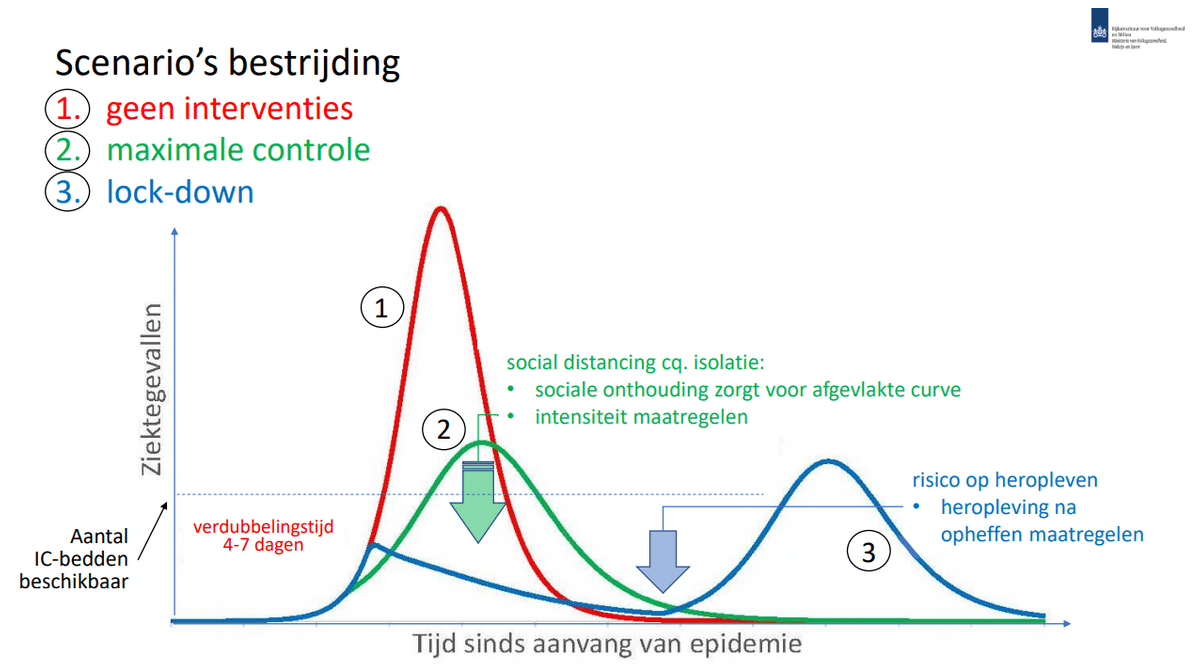
- March 18th: Geert Wilders (PVV) and Thierry Baudet (FvD) submit a motion requesting full lockdown. All other parties vote against it. Baudet also submits a motion requesting explicit enouncement of not trying to attain herd immunity before vaccine arrival and not letting the virus spread among those who supposedly will not be bothered greatly by it. 125 out of 150 seats vote against it, including the coalition. Wybren van Haga (independent) and Thierry Baudet submit a motion requesting efforts to obtain sufficient test materials to test all people with symptoms. Almost the whole opposition votes in favor of it, the coalition votes against it. It's rejected.
- March 18th: Health minister Bruno Bruins collapses due to exhaustion while participating in a debate in parliament. He subsequently tenders his resignation. Hugo de Jonge, deputy prime minister of the Netherlands and minister of health, welfare and sports, will take his place.
- March 18th: From now on, the GGD's in the north of the country will test more among health care workers, including asymptomatic ones. According to Alex Friedrich (doctor-microbiologist) they are already testing 3-5 times as much per capita at this point. (English article) They also do contact tracing. The outbreak will turn out to be relatively mild in the north (see image May 20th).
- March 18th: OMT member Aura Timen says about herd immunity:'That's the best protection if you don't have a vaccine yet. But we also fight the virus, we even go further than other countries.'
- March 20th: Television address by King Willem-Alexander: “we cannot stop the coronavirus”. (Translation)
- March 20th: Ban on visiting elderly care homes (insiders say this should have been announced much earlier).
- March 23rd: The so-called 'intelligent lockdown' is announced. What is forbidden from now on: groups of more than 2 in public places, most contact professions. Children are still allowed to play together, shops and markets can remain open as long as people keep 1,5 meter distance. (Snippet from press conference)
- March 25th: Jaap van Dissel briefly mentions the test/trace/isolate strategy used in Singapore, but dismisses it due to it requiring a large amount of tests and due to a supposedly high risk of later re-introductions.
- March 25th: Newspaper AD publishes an article that mentions Containment Nu! and also the fact that RIVM has not published data about the amount of people that have been tested in the first days of the outbreak. According to RIVM, that information isn't relevant during an outbreak, only afterwards.This article was mysteriously pulled shortly after publication. (Screenshot of deleted article)
Data about the number of tests performed prior to March 9th have not been published by RIVM, and the newspaper report about this was mysteriously pulled shortly after publication
- March 27th-30th: FSM publishes guidelines on when to preferably admit patients to hospital/ICU and when not to.(Guidelines here and here). The Netherlands is more reserved than other countries when it comes to this. Although there is a conversation about it with patients when possible, some experience it as being discouraged to seek care. (English article)
- March 31st: Press conference: Hugo de Jonge promises a more than fourfold increase in the capacity to test: from 4.000 tests performed per day (correct=3.500 max) to at least 17.500 and preferably 29.000. (See May 22nd for an update).
April
April is the month in which there's a lot of talk about how to go forwards. There is a lot of confusion about what the strategy is and will become. The concept of a 'one and a half meter society' is introduced. The peak in hospitalized patients will be around the 8th and ICU's will be able to cope, but barely and with some patient transfers to other provinces than North Brabant and to Germany. A lot of regular care is postponed.
- April 6th: The OMT has drawn up criteria that must be met in order for measures to be relaxed. The criteria are: 1. R below 1 for a while 2. Care no longer overwhelmed 3. Enough testing capacity. 4. Enough tracing capacity 5. Enough ways to monitor recent spread. Criteria 3+4+5 will not be met when the first measures are relaxed on the 6th of May and even not at the time of writing (May 30th).
- April 7th: Press conference: from April 6th onwards, people who have symptoms and who work with a vulnerable demographic or are vulnerable themselves can get tested. Or so it is promised. The desire to have a tracing app designed is expressed (there will be a competition, but no app succeeds, see May 29th for an update on apps).The 'one and a half meter society' is introduced. (Text of speech)
- April 13th: Around this time there are some articles praising Mark Rutte for how he deals with the crisis. The AD newspaper calls him 'guardian of the nation' and portrays him with a royal garment. Support for him has increased from 25-40% in the previous years to 70% now. The article does note that this could change drastically in the future.
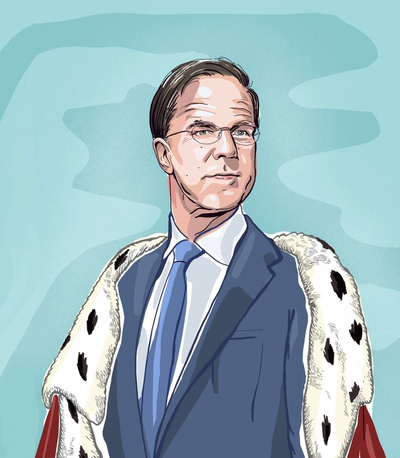
- April 19th: In an interview, Jaap van Dissel and Jacob Wallinga (member of the OMT and modeller) defend the strategy of building herd immunity. Van Dissel says any percentage of people being immune will be 'an invisible wall the virus will bounce off of'. Wallinga adds: 'Every immune person counts. But before it is really useful it, it has to rise to 60 percent. I imagine we are hoping for a vaccine or a therapy. But if that doesn't work, by then we'll be well on our way to that 60 percent.'
- April 20th: A newspaper reports that the percentage of people 70+ of age in ICU’s has gone down (41% on March 23th, 30% between April 8-16). (Article)
- April 21st: The ministry of health postpones dealing with corona related WOB requests (=Freedom Of Information request, FOI) till June the 1st and possibly till later, worrying some journalists and some members of parliament. (Article + Article)
- April 21st: Ann Vossen (member of the OMT, doctor-microbioloigist) appears on TV show Jinek and explains that the strategy is to allow the virus to spread slowly, including through children daycare centers and primary schools. (Video on Twitter)
- April 21st: Head of the GGD's Sjaak de Gouw says on TV that the amount of contact tracing is dependent on the amount of testing, which is dependent on the strategy. According to him we have a different strategy than Germany.
- April 22nd: The OMT advises conditional reopening of schools. (Report)
- April 24th: The NVIC (national association for intensive care) publishes a report with calculations of the needed ICU beds and time to reach herd immunity levels (50-70%).
- April 24th: From the 17th till the 24th a survey commissioned by the RIVM is done in which people are asked how they view the Dutch approach regarding the pandemic. According to the survey, 69% is positive or very positive about it.
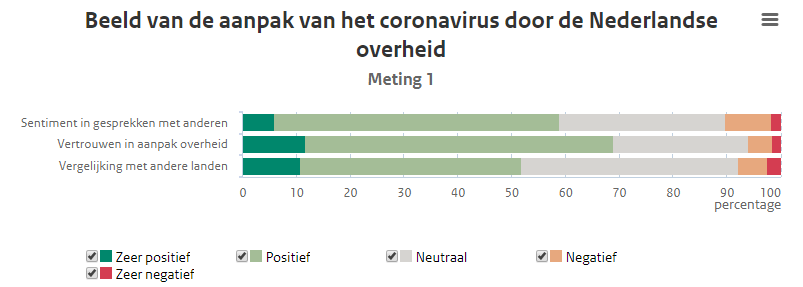
- April 25th: An investigative TV program criticizes the lack of transparency of the OMT and the lack of scientific substantiation (e.g. very little references given). Notes the confidentiality agreement speakers in the OMT have to sign. (Article)
- April 26th: Jan Kluytmans (member of the OMT, doctor-microbiologist) talks about raising ICU capacity, dreaming of ‘infinite’ capacity. (Original video + Subtitled Video on Twitter)
May
May is the month in which a lot of relaxations of measures are announced and even implemented. They come sooner than expected. The amount of people with COVID-19 on ICU's keeps going down to approximately 200 at the end of the month, creating 'room' to relax measures. Yo-yo lockdowns are part of the official strategy, though the cabinet and OMT members tell the public that they will try to prevent another semi-lockdown and are trying to keep the reproduction rate below 1. It is promised that testing will increase in June and that it will be followed by contact tracing. There is some critique, especially regarding the contact tracing blueprint.
- May 1st: Mathematician Bert Slagter talks about exponential growth/shrinkage on Dutch tv, advocates for a longer lockdown and intensive testing and tracing. (Snippet in Dutch)
- May 5th: 1 million antibody tests are bought to monitor spread.
- May 6th: In a letter to parliament, Hugo de Jonge presents a new model for the 'Maximum control' strategy which looks like mitigation at 50% of ICU capacity. It still has the same goals of protecting the vulnerable and protecting health care capacity. The goal of herd immunity is gone. There is a new goal regarding gaining insight in the spread. The model shows 4 phases: an outbreak phase, transition phase (May-August), control phase and vaccination phase.
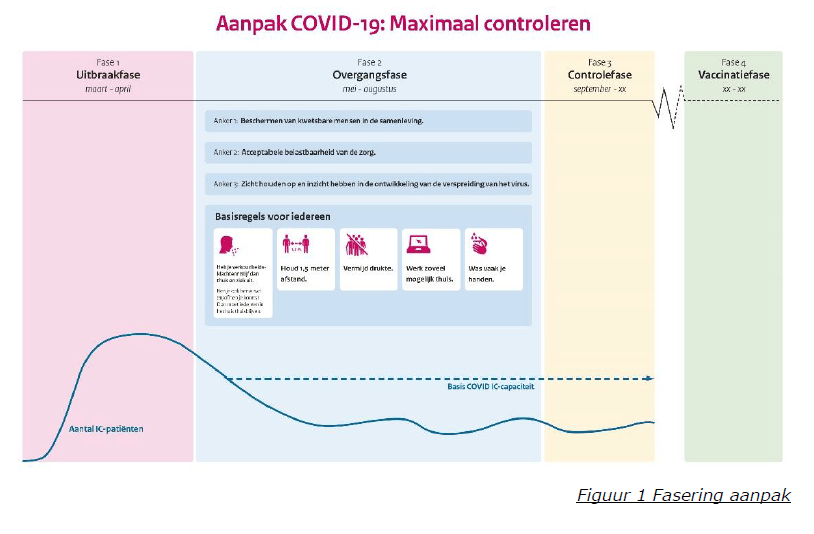
- May 6th: Press conference: Mark Rutte announces a timetable with the relaxations of measures planned and estimated, e.g. the opening of restaurants, pubs, theaters and museums for max. 30 visitors per June the 1st. ‘Stay at home as much as possible’ becomes ‘avoid busy areas’. Rutte also states that herd immunity is not a goal but a side-effect and that this is the strategy 'everywhere'. Besides that, he says that trying to eliminate the virus would lead to travel restrictions for the Dutch wanting to go abroad, even though the opposite is true. (Official update+transcribed speech).
- May 7th: During the technical briefing, Van Dissel explains that the decision to make non-medical masks in public transport mandatory per June 1st is not based on science and that it was only decided because 1,5 meter distance + a health check questionnaire isn’t possible in public transport. Still against ‘masks for all’, interpreting research in an incorrect way.
- May 7th: There's a debate in parliament again. The strategy is one of the main topics. Rutte says 'the strategy is unchanged since the speech that I held on March 16th' and 'It was, is and will be 'Maximum control'. He says aiming for a spread towards zero is possible but unwise, due to the supposed economical, social and emotional costs.' When Asscher asks him to choose between a containment strategy and allowing more people to get sick, Rutte says that when forced to choose he would choose the first option and that that is what 'Maximum control' means. But then he makes this statement that seems conflicting:
...this also means that we* both accept that there will be hospital admissions in the near future as well, that there will probably always be people on ICU's with COVID-19/corona in the near future, that unfortunately people will continue to die from it in the near future. That is a social fact that we therefore explicitly choose. ------------------------------------------------------------------------------------------------------------------------------------------------ *Mark Rutte and Hugo de Jonge (deputy prime minister of the Netherlands and minister of health, welfare and sports)
- May 7th: The concept of 'herd immunity' has really disappeared from the OMT talks due to disappointing antibody study results, says OMT member Marc Bonten. He also expresses that he thinks a containment strategy is impossible in The Netherlands.
- May 7th: In a debate, Rutte says the strategy hasn't changed since the 16th of March and that it will not change either. Says aiming for a spread towards zero is possible but unwise, due to the supposed economical, social and emotional costs.
- May 8th: From now on, hospital admissions are only registered as COVID-19 admissions if COVID-19 is the main reason for admission. This is because hospitals are testing more patients to prevent spread of the virus in hospitals.
- May 9th: In an interview, Van Dissel and Wallinga state that they are more concerned about people not complying than measures being lifted causing a second wave. There have been and will be more of these kinds of statements (e.g. from Mark Rutte in multiple press conferences, Anne Wensing in a TV show May 10th, RIVM director Hans Brug on TV May 17th, NOS news May 23rd).
- May 11th: Some relaxing of measures: primary schools open (groups are split, kids spend half the normal time at school), children day care centers open completely (was only for kids with parents in vital sectors), outdoor exercise at 1,5 meter distance permitted, libraries open, contact professions get back to work (mask not obligated, just a health check questionnaire when booking/entering). Plans for a lot more relaxing of measures (June 1st, July 1st, September 1st). (Official tweet)
- May 12th: From May the 7th till May the 12th the second round of the RIVM survey is executed. The results: the percentage of people that is (very) positive has increased from 69% to 73,4%, the percentage that is (very) negative has decreased from 6% to 4,7%.
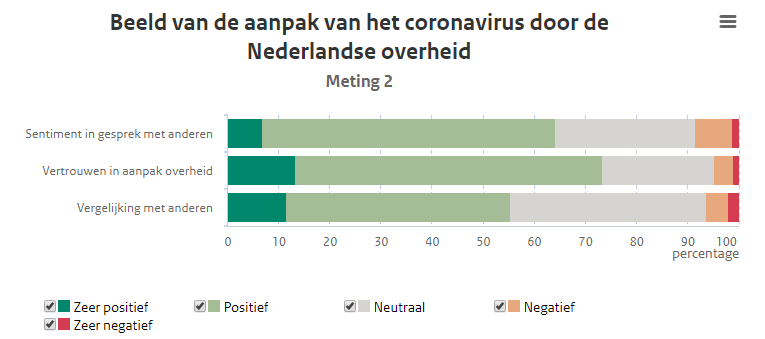
- May 14th: Lodewijk Asscher of the Dutch labour party PvdA wants to talk about the corona strategy and put the containment option on the table. 2 days later Lilian Marijnissen from socialist party SP writes a similar article.
- May 15th: CBS (central bureau for statistics) publishes the estimated excess mortality for the last 9 weeks. It calculated it to be almost 9.000 (confirmed COVID-19 deaths on this date: 5.634, that probably means 37% of COVID-19 deaths are not reported as such). The method used for calculating excess mortality is new. Some people note that with the new method, the expected mortality is higher, so calculated excess mortality turns out lower, by 1200 deaths at the 7th of June according to some.
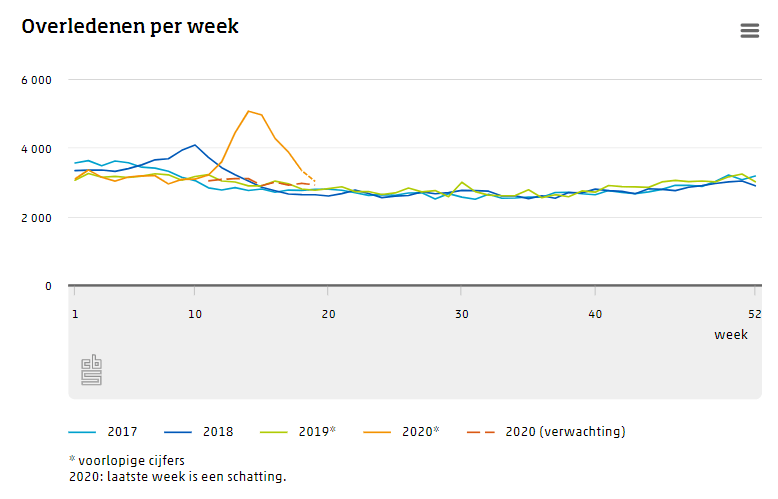
- May 15th: New guidelines released on the planned extension of contact tracing by the GGD’s starting June 1st. The plan is to test everyone with symptoms and trace their contacts. There is critique from some experts (e.g. quarantine is just advice, too many expected cases, just 5 hours per case). (Guidelines here + here)
- May 18th: GGD director Sjaak de Gouw says that trying to build herd immunity is the only thing that you can do and portrays containment as a strategy that would cause travel restrictions for Dutch people that want to go abroad, even though in reality it would increase the chance of travel being forbidden. (Original video + subtitled video)
- May 19th: According to a poll done by FNV (federation of trade unions) 60% of personnel working in elderly care homes and in home care still lacks PPE (and 1 in 3 in hospitals, 1 in 6 in postnatal care) Still no guideline that promises a right to PPE (promised by minister of health van Rijn on May 7th). (Article)
- May 19th: Hugo de Jonge still advocates for increasing ICU capacity from 1150 to 1700 and wants to be able to raise it to 3000 now and then to deal with peaks. Nurses and IC doctors have been saying for weeks that even an increase to 1700 is unrealistic, that there are already too little nurses and that Hugo de Jonge is not talking about ‘real’ ICU beds, with all possible care. (Article by V&VN, trade union of nurses)
- May 20th: In the technical briefing to parliament members, Van Dissel shows that the plan is on and off ‘lockdown’ for years. He shows the effect of doubling ICU capacity and he shows a map with the % of blood donors that have antibodies (3% on average, April 16th), that supposedly indicates immunity. (Tweet) The plan is to try to build immunity by infection and then hopefully complete it with a vaccine.
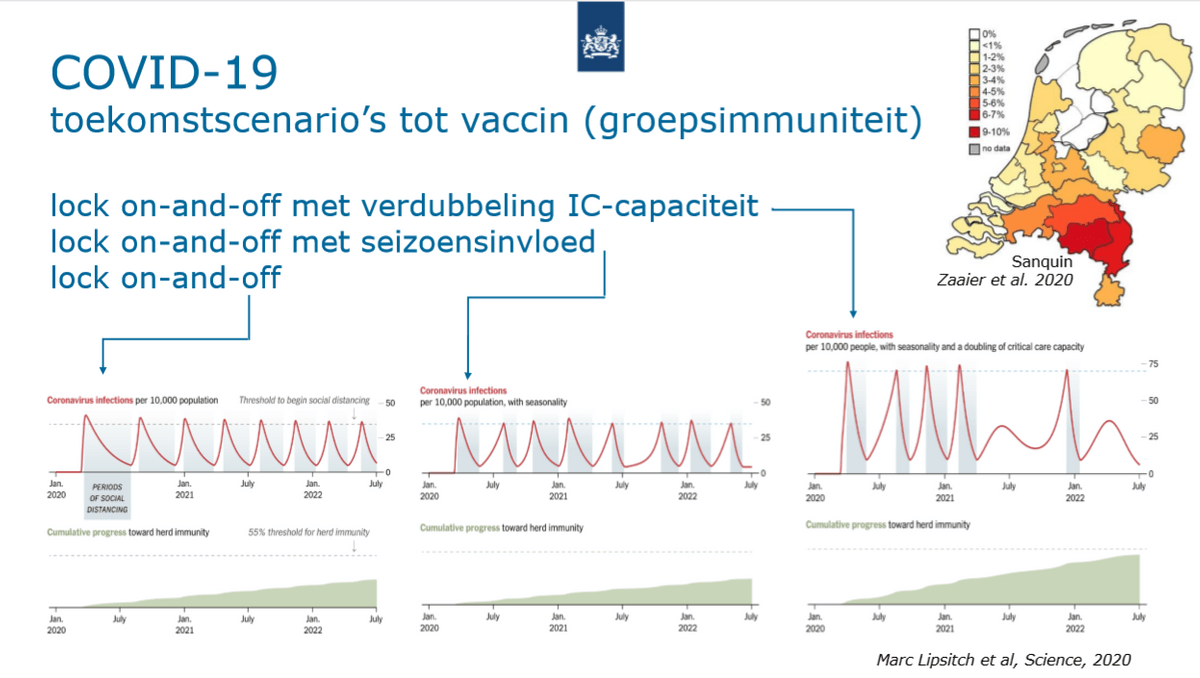
- Below you see the plan for the ICU's. A rise in ICU admissions serves as a warning signal. At the end of the red line, measures become stricter again. A wave reaching 1150 occupied ICU beds nevertheless ensues. The goal is then to get Rt down to 0,9.

- Van Dissel also shows a graph of R, it was just below 1 on May 1st. (Tweet) And he admits a 'mistake' he made last time: The Netherlands has one of the highest mortality rates per 100k in Europe, not one of the lowest.(Tweet)

- May 20th: There's also a debate in parliament this day. The strategy is one of the main topics. Klaas Dijkhoff from VVD calls it a 'macabre dance with the virus' that is supposedly inevitable. Rutte again portrays a containment strategy as needing a lockdown indefinitely. Claims that this would lead to more infections, since people would not comply with the rules anymore after some time.
- May 22nd: Update on tests performed since March 31st: the maximum average was 5.729 per day, the minimum was 4.116 (end date: May 17th). The promise was at least 17.500 and preferably 29.000.
- May 22nd: In depth news bulletin 'Nieuwsuur' asks the question: 'Does the opposition oppose?'. Parliament members express that there has been a wish for unity and to not add drama in a crisis. They express the desire to be a bit more critical from now on.
- May 23rd: Even though a 'one and a half meter society' is the goal, restaurants and pubs get permission to seat two people within 1,5 meter of each other when they open on the 1st of June, even when those people are not from the same household. KHN (royal association for the catering industry) admits that it's 'thanks to intensive lobbying'. (Article)
- May 23rd: OMT modeller Jacco Wallinga says in an interview 'The purpose is not to quench the virus. Then you should never relax measures and hold on to everything. A goal is to keep delivering good care. So you don't want ICU admissions to exceed capacity a lot. And then you can calculate back in time what the maximum you can handle is.'
- May 25th: OMT member and doctor-microbiologist Marc Bonten says the acquired herd immunity will likely be partial, because it takes a lot of time to build it within the limits of ICU capacity and hopefully there will be a vaccine sooner than that. 'And if not...then it will take a long time before herd immunity will deliver us from the 'new normal'.' He also emphasizes that even immunity of for example 20% of the population can allow for more relaxations of measures.
- May 25th: 147 out of 657 workers at a slaughterhouse (more than 1 in 5) have tested positive, 68 of them Dutch.It is discovered during sample research. Less than 10% of the workers have symptoms. It is the second time an outbreak in an abattoir is discovered.
- May 26th: According to a poll by AOB (general education union) 69% of primary school workers would rather see a continuation of children being tutored in small classes instead of regular sized ones, as is the plan from the 8th of June onwards. 2 in 3 stated that they have worked in their school even though they were afraid of getting infected. The first news items about infections in schools have come out in the previous days (example 1+2+3+4). Some schools close, while others see no problem as long as no one else develops symptoms.
- May 26th: According to a poll, the neo-liberal party VVD (party of Mark Rutte) would get 44 seats in parliament if elections were held now. That's a gain of 17 seats in 3 months and the highest they have been polled since 2012.
- May 27th: Press conference: it is announced that some relaxations of measures will come sooner than planned. Gyms, sauna's and casino's will likely open on the 1st of July, instead of the 1st of September. Mark Rutte mentions that in the near future, travel will only be possible to countries with comparable rates of infection and not countries with more infections. He doesn't mention that The Netherlands will likely become a 'red zone' and so only able to travel to other red zones or not at all.
- May 29th: The cabinet installs an emergency law and gives the RIVM permission to use anonymized data from telecom masts for a year max. The purpose is to get more date on how people move, where it's crowded and where those people come from. This way there is more recent data on possible spread of the virus.
- May 29th: There is a plan to test a tracing app in the first half of June. It's not sure yet if it can be put into use before the end of the summer.
- May 31st: Ann Vossen says in an interview that even if they could've tested everyone with symptoms, they wouldn't have, because the (partial) lockdown already dampened spread.
June
- June 1st: Today is the first day all people with symptoms can call a national number to make an appointment for a free test. 323.000 calls are made, 5.500 people get an appointment and 1.100 get an appointment for the same day. A bit over 52.500 tests will be done the first week (compared to a bit over 33.500 tests the week before).
- June 1st: Restaurants, pubs, theaters and museums re-open for a maximum of 30 visitors. Restaurants and pubs can receive more customers, as long as the 1,5 meter rule can be respected. Almost half of restaurants and pubs remain closed.
- June 1st: 5.000-10.000 people attend a Black Lives Matter protest at the Dam square in Amsterdam. Most wear masks, but the 1,5m distance rule cannot be managed everywhere. There's a lot of fuss about it. Many people want mayor Famke Halsema to resign even. Three days later, demonstrations are forbidden at Dam square until further notice.
- June 2nd: High schools re-open.
- June 3rd: Infections in minks have been detected in 8 mink breeding farms. The first case was detected at the end of April. It is suspected that 2 workers got infected by a mink. All the minks in farms with infections, meaning tens of thousands of minks, will be gassed.
- June 3rd: Press conference: One of the main topics is holidays. It is advised to only go to 'yellow' European countries and the Carribean part of the Kingdom this summer. Only people from countries with a similar situation will be allowed in The Netherlands.
- June 4th: Technical briefing. There are a few topics:
- 1. Tourism. Curiously, Van Dissel shows a graph with the 10 most affected countries worldwide (total cases). The Netherlands is at the bottom of these. But if you for example plot the 10 most popular holiday destinations, which is more relevant, you see half of them have less infections than The Netherlands.

- 2. The speed of testing. Van Dissel expresses that ideally, one should get the result in one day. Right now it can take a few days to get tested and a few days to get the result. The current aspiration according to the guidelines is to get the result in 48 hours.
- 3. Transmission by children: according to a Dutch study children being the source of infection is unlikely. The study group consisted mainly of infected care workers. While the research was executed, schools were closed.
- June 4th: Debate in parliament: prime minister Mark Rutte flat out denies ever having given a speech about herd immunity.
- June 5th: The first trial version of the 'dashboard', a tool to monitor spread, is made public. Its parameters are: ICU admissions, hospital admissions, people that test positive (per 100k residents, per day), estimated amount of infectious people (per 100k residents), estimated reproduction rate R, information on behavior and other factors. There are 'signal value's' regarding ICU- and hospital admissions and the reproduction rate. Even when measures are taken when these values are reached, a second wave will most likely follow (see May 20th).
- June 5th: Press conference: Rutte announces that the 'crisis structure' is abandoned for an indefinite period of time.
- June 5th: In an interview for newspaper 'Volkskrant', Jaap van Dissel says: 'Because this is a pandemic virus, I think it's an illusion to think that it will disappear. And that means that you have to build immunity. Or the vaccine will be there first.'
- June 6th: Minister of health Hugo de Jonge has put together the first version of a statute which would temporarily cement the 1,5 meter rule and forbidden group formations into law, starting July the 1st. Right now, those rules are only part of an emergency order.
- June 8th: Primary schools go from teaching half classes to full classes again.
- June 9th: The parliament votes on a motion by Lodewijk Asscher (PvdA) and Lilian Marijnissen (SP) requesting an impartial advice from external experts before the 1st of September. The whole opposition votes in favor of it, the whole cabinet votes against it, making it a tie. A few days later, newspaper Volkskrant reports that the cabinet has asked OVV (Dutch Safety Board) to take a look at the handling of the corona crisis. The results will take a year. The difference in preferred timelines might have to do with the elections in March 2021.
- June 9th: 'Nieuwsuur' investigates the test capacity of the previous months. It turns out that there was much more capacity than what was put to use, even though the OMT and the cabinet consistently spoke about scarcity and impending shortages, using those to justify a minimal testing policy. It is said that the little testing has led to preventable deaths, especially in elderly care homes.
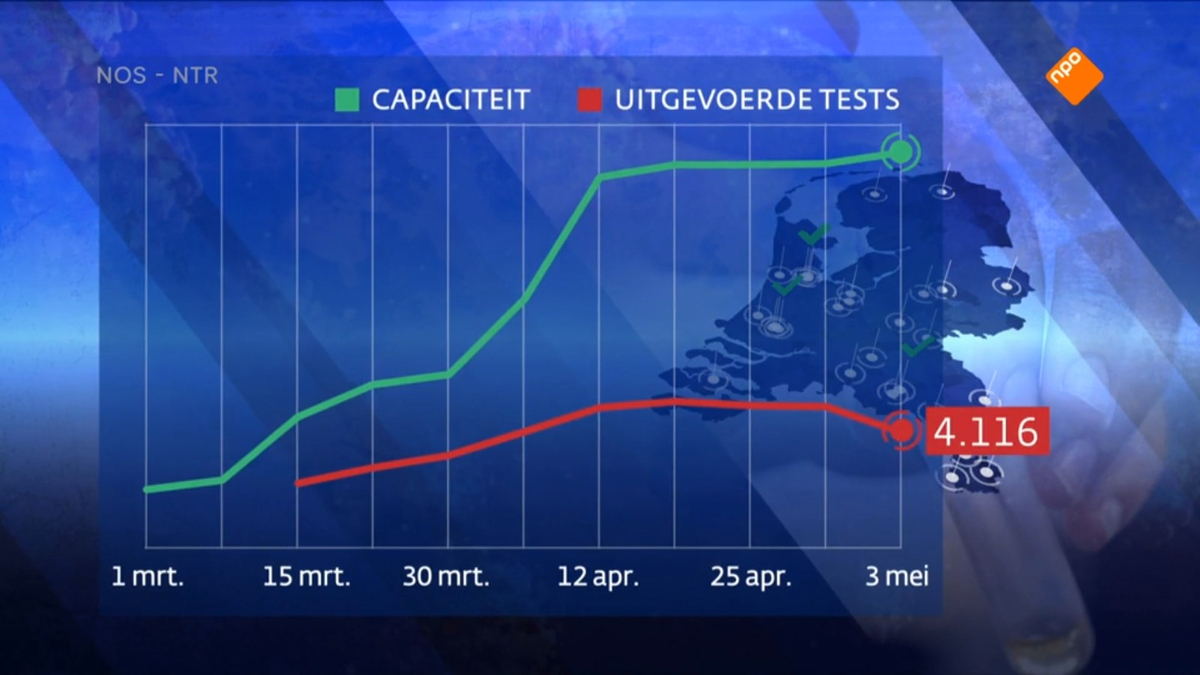
- June 10th: From now on, RIVM will stop posting daily updates on Twitter with corona virus related statistics and only post once a week. Daily updates will only be posted on the website.
- June 16th: Parliament votes again on the motion regarding impartial advice on the handling of the corona crisis (see June 9th). This time, all present 141 parliament members vote in favor of it.
- June 18th: Jaap van Dissel says in an interview: 'We don't want to let the virus spread. We want to keep it as small as possible. Although you have to realize that we will keep getting little resurgences, like we see now in China, South-Korea and Germany.' For your information: The Netherlands has more new confirmed cases per day than China and South-Korea and more per million capita than all three of them.
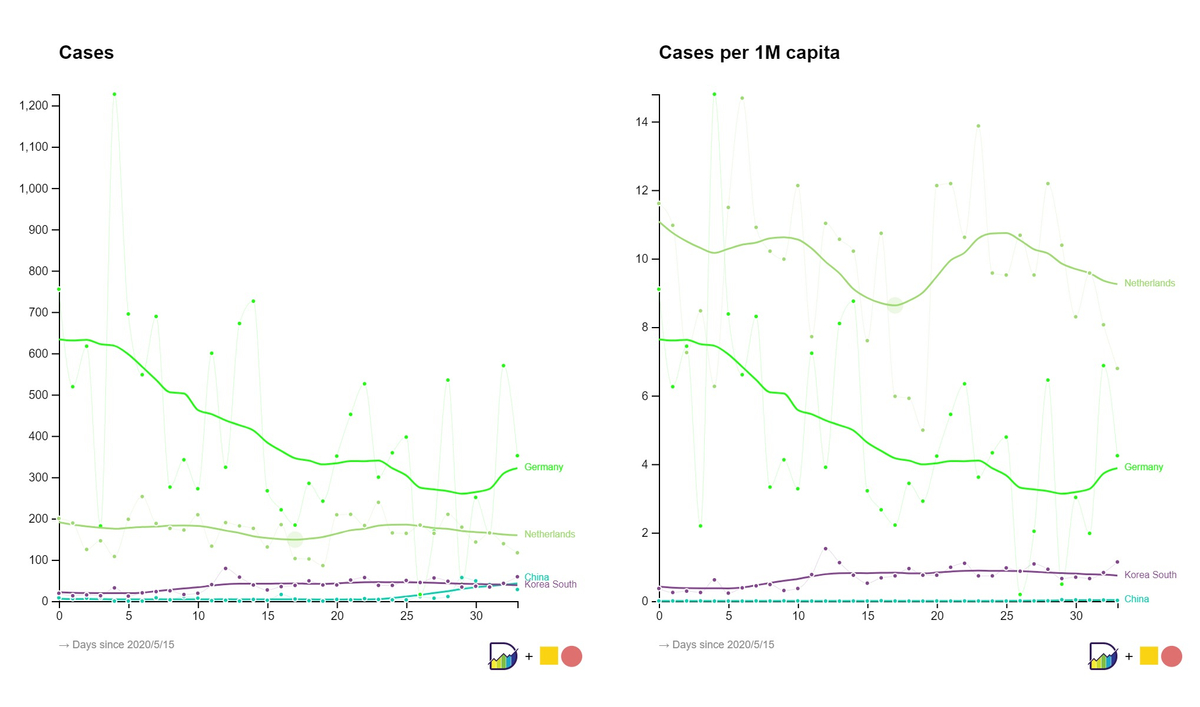
- June 21st: There is a demonstration in The Hague by action groep 'Viruswaanzin' ('Virus madness') and its followers. It was forbidden at first, but eventually allowed, because people showed up anyway. Viruswaanzin is a group that believes the virus isn't worse than the flu, that only 70 people have died from it (the other thousands supposedly died due to their underlying condition), that more people died due to the measures than the virus and that herd immunity will be reached if just 25% of the population gets infected. The group wants all measures lifted to get their freedom and normality back.
- June 23rd: In the periodic advice to parliament from the OMT a seemingly new definition of the 'Maximum control' strategy is introduced: 'to contain the virus as much as possible, causing the number of new infections to go to (near) zero, because of which new outbreaks will be prevented or kept in control. The goal is to sustainably keep Rt below 1.' In an interview, Van Dissel says there's nothing new about it, that it's just semantics and that the perceived difference might have to do with the fact that in the beginning they didn't know whether containing the virus was possible. For your information: the current situation is seen as having contained the virus. At the same time Van Dissel calls herd immunity a long term prospective, seemingly talking about or at least including herd immunity by infection.
- June 25th: The new definition of the 'Maximum control' strategy (see June 23rd) is not adopted by the cabinet as evidenced in the letter to parliament from Hugo de Jonge. In the letter two goals are named: protecting the vulnerable and protecting health care capacity. For that, insight in the spread is needed. An increase in infections needs to be fought, but there doesn't seem to be a desire to bring the current level of infections further down. Also, it is said that the control phase starts the 1st of July, 2 months earlier than expected.
- June 25th: On this same day Marijnissen from SP asks Rutte if the strategy is containment. Rutte says yes and refers to the letter from De Jong which in reality portrays a mitigation strategy at 50% of ICU capacity (see May 6th).
- June 25th: The action group Viruswaanzin appears in court to fight the state in order to get all measures lifted.
July
- July 1st: On this day, the official strategy page disappears and redirects to a page about the OMT where a small paragraph about the strategy appears the next day. There are no mentions anymore of herd immunity, protecting the vulnerable and protecting health care capacity etc. It still speaks about 'spreading out' the disease and 'gradual spread' though.
- July 3rd: From now on, there is data about sewage testing in the corona dashboard.
- July 7th: The paragraph about the strategy (see July 1st) has changed again. There is no more talk about spreading out the disease and controlled spread. Instead there is something about the importance of testing and tracing in order to contain the virus 'once it rears its head'. This can be seen as a positive change. At the same time, it implies that the virus is contained right now (reality: in June there have been between 334-1222 people who tested positive per week and compliance to test is low).
August
- August 17th: The first primary and secondary schools open in the North after the Summer holiday. Full classes are taught and these are the rules: children up to and including 12 years of age do not have to keep distance from each-other or adults. From 13 up to and including 17 years of age, no distance is needed from each-other, but distance from adults is needed. Only in secondary vocational education (MBO) and higher education students need to keep distance from each-other and adults. Small children up to 4 years old are allowed to attend day care or primary school with cold symptoms and do not need to get tested.
- August 27th: The need for ventilation is starting to get 'air time'. This is for example seen in the supplemented page on children and schools from RIVM. It is recommended to open windows, ventilation grilles or use mechanical ventilation system. At the same time it is said that if buildings comply to the Dutch Buildings Decree (Bouwbesluit), that is enough as a minimum. These requirements however were never meant to prevent the spread of a virus. Experts say it's not enough and that they regret not having been consulted.
September
- September 8th: OMT member Marc Bonten writes an article about the strategy. In it he calls containment control and mitigation containment ('indammen'). Then he uses the supposed impossible eradication of the virus to support the current strategy. He says that in his opinion we are doing containment to the extent that it is possible and desirable, but that if others think it's mitigation that's fine. He also makes some comparisons with flu and other diseases that can cause lung infection, saying 'Vulnerable people are at risk for lung infection and hospital admission every year, so why not accept that now as well, as long as accessibility to care is not threatened?'.
'Vulnerable people are at risk for lung infection and hospital admission every year, so why not accept that now as well, as long as accessibility to care is not threatened?'
- September 18th: Press conference: because of the continued growth of detected cases since the beginning of July, new measures are announced for the 6th regions that are hit the hardest: bars and restaurants have to close 1 hour earlier (1:00) and people cannot gather in groups bigger than 50 without permission. Until further notice, children up to and including 12 years of age do not need to get tested anymore if they have mild symptoms, because they supposedly barely play a role in the spread and also to decrease pressure on the overloaded test facilities.
- September 20th: TV show 'Zondag met Lubach' highlights issues concerning testing, exposing among other things the conflict of interest of OMT member Ann Vossen. Ann Vossen is chairman of the association of medical microbiology. The small labs governed by this association were instructed to carry out tests while the bigger hospital labs were excluded, creating an artificial shortage (episode with English subtitles here).
- September 20th: Since September, soccer matches with an audience are allowed again, provided that people stay quiet. On this day there is a soccer match where people yell and sing. Spokesman Raymond Salomon wonders if it can be prevented in the future due to the nature of the event. One day later, Mark Rutte says supporters should 'just shut up' ('gewoon je bek houden').
- September 22nd: There's a technical briefing called 'Update second wave'. In it Jaap van Dissel uses Tomas Pueyo's famous 'The hammer and the dance' graph to insinuate that we are doing containment, by putting The Netherlands' hospital admissions next to it, which look similar in a graph. We are not doing everything that belongs to 'the dance' though: R has been above 1 for weeks, there is a lack of testing, tracing and most importantly: the necessary 'tightening up' is not happening, because hospitals can still cope.
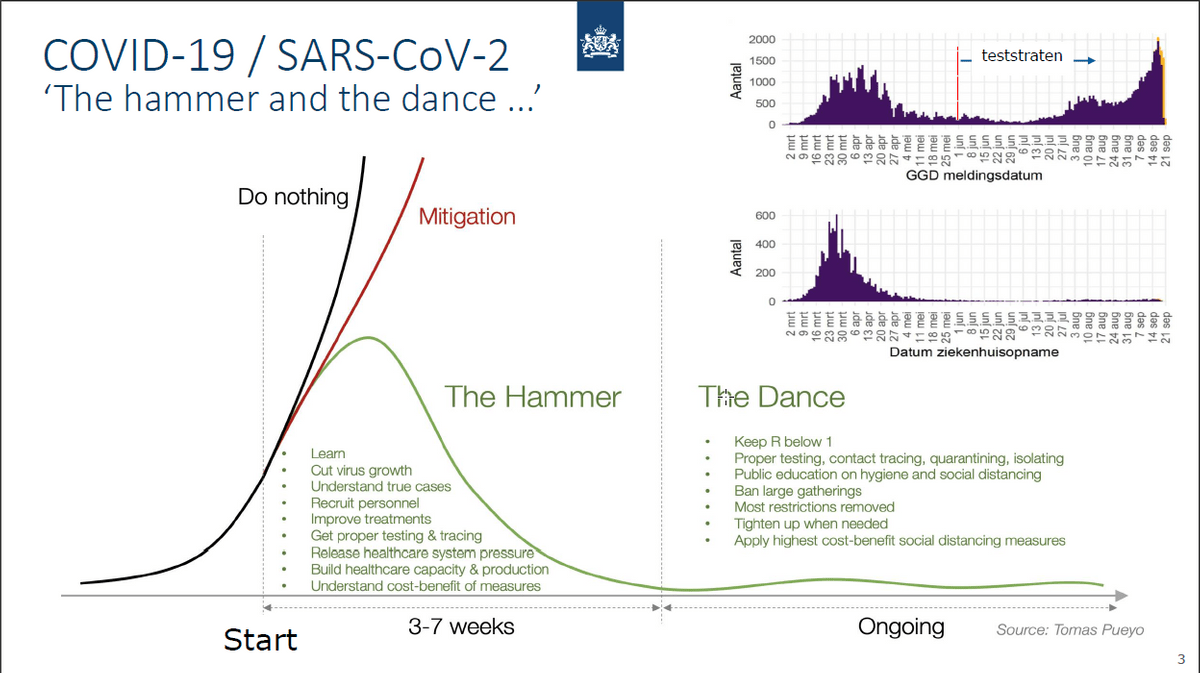
- September 24th: Up to a 1000 soccer fans are allowed to watch a match together on a big screen in Tilburg, because according to mayor Theo Weterings, they would otherwise meet somewhere anyway. They don't keep distance and sing and yell. The police doesn't intervene, because it fears escalation. The mayor blames the crowd for the incident.
- September 25th: In the press conference, it is announced that 8 more regions have worrying levels of infection, on top of the 6 regions announced in the press conference on the 18th of September. In these regions, the same extra measures will be installed: permission needed for group meetings with over 50 participants, bars that close 1 hour earlier (1:00). Emphasis is placed on the importance of social distancing and the responsibility of the public. Rutte says; 'In the end there is only one measure that is effective, one measure. And that's our behavior.' That night in a TV show, Rutte goes as far to say: 'Don't look at me or Hugo de Jonge, what we contrive. Comment on the behavior of the people around you, stick to the rules, because when you do that, you don't need me.'
'In the end there is only one measure that is effective, one measure. And that's our behavior.' '....stick to the rules, because when you do that, you don't need me.'